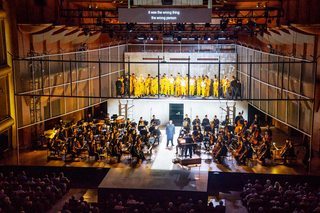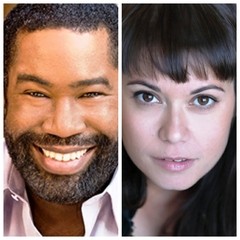|
Back
David Lang’s Ode to Beethoven’s Freedom New York
David Geffen Auditorium, Lincoln Center
06/06/2019 - & June 7, 8, 2019
David Lang: prisoner of the state
Julie Mathevet (The Assistant), Eric Owens (The Jailer), Alan Oke (The Governor), Jarrett Ott (The Prisoner), Matthew Pearce, John Matthew Myers, Steven Eddy, Rafael Porto (Guards)
Men of the Concert Chorale of New York (Chorus of Prisoners), David Nally (Chorus Master), New York Philharmonic Orchestra, Jaap van Zweden (Conductor/Music Director)
Matt Saunders (Scenic Designer), Maarten Warmerdam/Theatermachine (Lighting Designer), Adam Larsen (Projection Designer), Maline Casta (Costume Designer)

D.Lang/J. van Zweden (© Peter Serling/HK Phil)
“While there is a lower class I am in it. While there is a criminal element I am of it. While there is a soul in prison I am not free.”
Eugene V. Debs (1855-1926)
“Seeing yourself as separate from the universe is a delusional prison.”
Alfred Einstein (1880-1952)
David Lang’s consistent inconsistency has frequently depended on the originality of others. Whether The Little Match Girl Passion or Thomas Bernhard’s The Loser, Mr. Lang’s adoration of words is transformed to new, daring, and somehow always accessible creations.
Last night, Mr. Lang’s template was the Titan himself: Ludwig van Beethoven. And in the world premiere of prisoner of the state, he has made both a Titanic addition to the language of freedom, and an almost quirky paean to Beethoven’s lesser music.
After all, Fidelio, upon which his opera is based, was, for its time, just another trendy “escape opera”, loaded with subplots and humor as well as heroism. Yet David Lang, fashioning his libretto on a pruned down (and much more muscular version of the original Fidelio, along with sardonic quotes from Machiavelli and references to Hannah Arendt, has produced a work which is ideologically his most powerful.
And which takes its place along with the visions of Luigi Nono and the fearsome Prisoner by Dallapiccola.
Yet Mr. Lang resisted making prisoner of the state an “unconventional” opera. In fact, it was formed as a reflection of Beethoven’s own styles. Yes, we had the touching prisoners’ choruses. We also had a typical early 18th Century trio, we had a quartet, we had some primitive stage special effects.
We had, then, a work which Beethoven would have recognized, and indeed, would have approved. As would Amnesty International today.

prisoner of the state set, E. Owens (center) (© Chris Lee)
Yet how it did change the New York Philharmonic Hall! Rather than the pristine walls of the concert hall, we had grimy grey surroundings, a fence hanging halfway down the stage, an upper stage with men in prison garb. Later they would be replicated in black-and-white projections, images of the German movie Metropolis. The New York Philharmonic players were donned with ugly caps. The walls of the auditorium would soon have projections of faces, and the background would have a gigantic figure of the eponymous “prisoner” , Jarrett Ott, singing his woes.

E. Owens/J. Mathevet
(© Dario Acosta/Céline Nieszawer)
On stage were the major figures: the diminutive “assistant” (nameless but obviously Leonora, played by the lyrical miracle, Julie Mathevet); the poor jailer, a foreboding figure soon to be tamed down to size, with the great voice of Eric Owens; and the Governor, Alan Oke, dressed in purple jacket, a figure of Iago-like evil, his voice both unctuous and viscous, rising up to falsetto anger.
Mr. Lang’s libretto had cropped the mediocre original by Georg Friedrich Treitschke (correctly obscure), yet the story was the same, starting with the faithful (“fidelio”) wife disguised to help rescue her husband who had committed an unknown crime.
Mr. Lang comes close to describing it in a prisoner’s chorus:
“They say I said the wrong thing to the wrong person at the wrong time in the wrong place.”
The three main characters visit the nameless prisoner who crawls out of the stage floor, the Governor is about to kill him, when the Assistant reveals herself, and all ends...well, far more triumphantly at the end.
As Lang notes, the original moral had been woman’s loyalty to man. Here, Mr. Lang repeats Jean-Jacques Rousseau’s memorable quote: “We are born free, but everywhere we are in chains.” Finishing with Lang’s own words, “We need to know you see us...If you can see us, we can be free.”
With its hour-plus duration prisoner of the state is a verbal, political and dramatic triumph. So now we come to the music.
David Lang can create melodies as rich as any composer today, and here, in celebration of 1805, they are styled like any singspiel (with the same talking as the original). So on the surface, the solos speak for themselves.
It opens with Ms. Mathevet explaining the feelings of a woman (albeit a magnetic opening line “I was a woman once.”) Eric Owens, towering over his Assistant, sings a ditty which could have come from the 18th Century Beggar’s Opera, “In this world, without gold, you can’t live, you can’t be happy.” The Governor has two set-pieces, one the Machiavellian “Better to be feared than loved”, this addressed to the audience. The Prisoner has his own tale of despondency, in a massive projection on the back wall.
This, though, was David Lang’s genius. For whenever one felt that the music was prosaic, too self-consciously “operatic”, then one had to listen to the New York Philharmonic behind the voices.
The orchestral colors were shattering, not so much an accompaniment, as a fierce counterpoint to the melodies. So emotionally unlike the voices, that I started listening to the New York Phil rather than the voices themselves. The sounds were frequently percussive, yet not with a single “Bang” so much as a series in eccentric meter. At one point, the whole cello section chimed in with a strange litany. At another point, the orchestra shivered and almost cried over a melody. At other times, Mr. Lang used this orchestra with different strains entirely, not with motifs (that would be too simple) but with whole orchestral tapestries.
Somehow the blends worked. They didn’t merge so much as present another dimension to the opera. We didn’t have to “understand” the differences as to allow the sounds to whirl in our own minds.
Thus prisoner of the state became the state of our minds. Jaap van Zweden conducted all his forces with the spirited conviction he gives to Mahler–or Beethoven. The men of the Concert Chorale of New York had as many choruses as the soloists combined, all projected, clear and as forceful as choruses of the original Fidelio.
As it stands now, prisoner of the state has more than potential as a lasting opera. The music of course needs great orchestras, fine soloists, an excellent chorus. But more than that, the concept is so honest that Mr. Lang might wish to distribute videos of the performance to countries which can’t afford their own productions.
Those numerous countries whose leaders, like David Lang’s wicked Governor, have persecuted their citizens, micturating on our inborn humanity of self-direction and self-determination.
Harry Rolnick
|